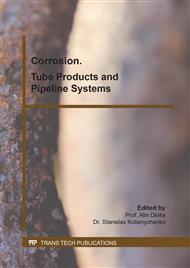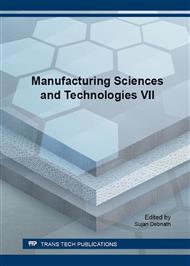[1]
J. D. Tucker, M. K. Miller, and G. A. Young, Assessment of thermal embrittlement in duplex stainless steels 2003 and 2205 for nuclear power applications., Acta Materialia 87 (2015): 15-24.
DOI: 10.1016/j.actamat.2014.12.012
Google Scholar
[2]
M. Wang, C. Lei, X. Liu, and X. Ma, Influence of thermal aging on the SCC susceptibility of wrought 316LN stainless steel in a high temperature water environment, Corrosion Science 81 (2014): 117-124.
DOI: 10.1016/j.corsci.2013.12.011
Google Scholar
[3]
T. Takeuch, Y. Kakubo, Y. Matsukawa, Y. Nozawa, T. Toyama, Y. Nagai, Y. Nishiyama, J. Katsuyamac, Y. Yamaguchic, K. Onizawac, and M. Suzukia, Effects of thermal aging on microstructure and hardness of stainless steel weld-overlay claddings of nuclear reactor pressure vessels, Journal of Nuclear Materials 452, no. 1 (2014).
DOI: 10.1016/j.jnucmat.2014.04.003
Google Scholar
[4]
K. H. Lo, C. T. Kwok, W. K. Chan, and D. Zeng, Corrosion resistance of duplex stainless steel subjected to long-term annealing in the spinodal decomposition temperature range., Corrosion Science 55 (2012): 267-271.
DOI: 10.1016/j.corsci.2011.10.027
Google Scholar
[5]
J. Zhou, J. Odqvist, M. Thuvander, S. Hertzman, and P. Hedström, Concurrent phase separation and clustering in the ferrite phase during low temperature stress aging of duplex stainless steel weldments., Acta Materialia 60. 16 (2012): 5818-5827.
DOI: 10.1016/j.actamat.2012.07.022
Google Scholar
[6]
Chandra, S. Kalyan, V. Shankar, K. Mariappan, R. Sandhya, and P. C. Chakraborty, Effect of strain rate on the low cycle fatigue behavior of 316L (N) stainless steel weld joints., Procedia Engineering 55 (2013): 176-180.
DOI: 10.1016/j.proeng.2013.03.239
Google Scholar
[7]
J. Marrow, D. Engelberg, A. Jivkov, P. Wood, L. Babout, and N. Stevens, Grain boundary control for improved intergranular stress corrosion cracking resistance in austenitic stainless steels: new approach., Energy Materials (2013).
DOI: 10.1179/174892406x142723
Google Scholar
[8]
D. T. Spencer, M. R. Edwards, M. R. Wenman, C. Tsitsios, G. G. Scatigno, and P. R. Chard-Tuckey, The initiation and propagation of chloride-induced transgranular stress-corrosion cracking (TGSCC) of 304L austenitic stainless steel under atmospheric conditions., Corrosion Science 88 (2014).
DOI: 10.1016/j.corsci.2014.07.017
Google Scholar
[9]
A. Järvenpää, L. P. Karjalainen, and M. Jaskar, Effect of grain size on fatigue behavior of Type 301LN stainless steel, International Journal of Fatigue 65 (2014): 93-98.
DOI: 10.1016/j.ijfatigue.2013.05.012
Google Scholar
[10]
T. P. Gabba, P. T. Kantzosb, J. Telesmana, J. Gaydaa, C. K. Sudbracka, and B. Palsa. Fatigue resistance of the grain size transition zone in a dual microstructure superalloy disk, International Journal of Fatigue 33. 3 (2011): 414-426.
DOI: 10.1016/j.ijfatigue.2010.09.022
Google Scholar
[11]
J. Zhang, and Y. Jiang, Fatigue of polycrystalline copper with different grain sizes and texture, International Journal of plasticity 22. 3 (2006): 536-556.
DOI: 10.1016/j.ijplas.2005.04.006
Google Scholar
[12]
X. Yang, J. Zhou, and X. Ling, Influences of surface grain size and gradient variation along depth on fatigue life of metallic materials., Materials & Design 43 (2013): 454-459.
DOI: 10.1016/j.matdes.2012.07.026
Google Scholar
[13]
C. A. Sweeney, B. O'Brien, F. P. E. Dunne, P. E. McHugh, and S. B. Leen, Strain-gradient modelling of grain size effects on fatigue of CoCr alloy, Acta Materialia 78 (2014): 341-353.
DOI: 10.1016/j.actamat.2014.06.044
Google Scholar



